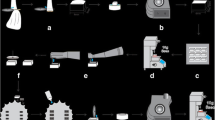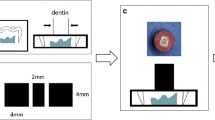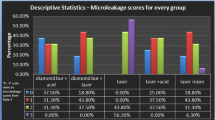Abstract
Purpose
This study has compared morphological characteristics of dentin and enamel surfaces after cavity preparation by conventional methods and Er:YAG laser irradiation in different settings by using an Er:YAG laser scanner.
Methods
Thirty-five human teeth were randomly divided into seven groups that received cavity preparations as follows: G1 and G2 with high-speed drill with diamond and carbide burs, respectively, and G3 to G7 with Er:YAG laser scanner (λ = 2940 nm) operating at pulse energies (energy densities) of 420 mJ (840 J/cm2), 490 mJ (980 J/cm2), 560 mJ (1120 J/cm2), 630 mJ (1260 J/cm2) and 700 mJ (1400 J/cm2), respectively. The lased groups were treated with Er:YAG laser scanner in non-contact mode, keeping both frequency (20 Hz) and pulse duration (300 μs) fixed. Samples were sectioned and scanning electron micrographs of the lateral wall of the cavities were taken at different magnifications.
Results
The results showed that both groups of conventional cavity preparations exhibited enamel and dentin surfaces covered by smear layer, with no dentin-enamel boundary being identifiable. All lased groups showed clear enamel-dentin boundaries and clean surfaces of enamel and dentin with different micro-morphologies. The morphology of lased dental surfaces presented homogeneous alterations.
Conclusions
The Er:YAG scanner-assisted cavity preparation produced topographies in the entire dental surfaces and whose morphological characteristics were more favourable to further adhesion of resin restorations than the conventional ones.



Similar content being viewed by others
References
Hibst R, Keller U (1989) Experimental studies of the application of the Er:YAG laser on dental hard substances: I. Measurement of the ablation rate. Lasers Surg Med 9:338–344
Keller U, Hibst R (1989) Experimental studies of the application of the Er:YAG laser on dental hard substances: II. Light microscopic and SEM investigations. Lasers Surg Med 9:345–351
Ando Y, Aoki A, Watanabe H, Ishikawa I (1996) Bactericidal effect of erbium YAG laser on periodontopathic bacteria. Lasers Surg Med 19:190–200
Sharon-Buller A, Block C, Savion I, Mordehai S (2003) Reduced bacteria levels in cavities prepared by Er:YAG laser. J Oral Laser Applic 3:153–155
Matsumoto K, Nakamura Y, Mazeki K, Kimura Y (1996) Clinical dental application of Er:YAG laser for class V cavity preparation. J Clin Laser Med Surg 14:123–127
Sonntag KD, Kutzman B, Burkes J, Hoke J, Moshonov J (1996) Pulpal response to cavity preparation with the Er:YAG and Mark 111 free electron lasers. Oral Surg Oral Med Oral Pathol Oral Radio1 Endod 81:695–702
Cozean C, Arcoria CJ, Pelagalli J, Powell GL (1997) Dentistry for the 21st century? Erbium:YAG laser for teeth. J Am Dent Assoc 128:1080–1087
Bertrand MF, Brulat N, Lazzarini V, Marcato G, Namur S, Roca JP (2008) Er:YAG laser cavity preparation and semi-direct composite resin restoration: a microleakage study. Photom Laser Surg 26:473–477. doi:10.1089/pho.2007.2182
Frentzen M, Koort HJ (1992) Histological investigation of mid infrared laser ablation of dental hard tissue. In: International Congress on Laser in Dentistry, 3. Salt Lake City, Aug., 6–8,. Proceedings. Bologna: ISLD; 243–244.
Mello AM, Mayer MP, Mello FA, Matos AB, Marques MM (2006) Effects of Er:YAG laser on the sealing of glass ionomer cement restorations of bacterial artificial root caries. Photomed Laser Sur 24:467–473
Matsumoto K, Wang X, Zhang C, Kinoshita J (2007) Effect of a novel Er:YAG laser in caries removal and cavity preparation: a clinical observation. Photomed Laser Surg 25:8–13
Manhães L, Oliveira DC, Marques MM, Matos AB (2005) Influence of Er:YAG laser surface treatment and primer application methods on microtensile bond strength self-etching systems. Photomed Laser Surg 23:304–312
Tachibana A, Marques MM, Soler JM, Matos AB (2008) Erbium, chromium:yttrium scandium gallium garnet laser for caries removal: influence on bonding of a self-etching adhesive system. Lasers Med Sci 23:435–441
Trevelin LT, Marques MM, Aranha AC, Aranha-Chavez VE, Matos AB (2015) Effect of super short pulse Er:YAG laser on human dentin—scanning electron microscopy analysis. Microsc. Res Tech 78:472–478. doi:10.1002/jemt.22496
Aoki A, Ishikawa I, Yamada T, Otsuki M, Watanabe H, Tagami J, Ando Y, Yamamoto H (1998) Comparison between Er:YAG laser and conventional technique for root caries treatment in vitro. J Dent Res 77:1404–1414
Aranha ACC, Eduardo CP, Gutknecht N, Marques MM, Ramalho KM, Apel C (2007) Analysis of the interfacial micromorphology of adhesive systems in cavities prepared with Er,Cr:YSGG, Er:YAG laser and bur. Microsc Res Tech 70:745–751
Lin S, Caputo AA, Eversole LR, Rizoiu I (1999) Topographical characteristics and shear bond strength of tooth surfaces cut with a laser-powered hydrokinetic system. J Prosthet Dent 82:451–455
Bertrand MF, Semez G, Leforestier E, Muller-Bolla M, Nammour S, Rocca JP (2006) Er:YAG laser cavity preparation and composite resin bonding with a single-component adhesive system: relationship between shear bond strength and microleakage. Lasers Surg Med 38:615–623
Visuri SR, Gilbert JL, Wright DD, Wigdor HA, Walsh JT Jr (1996) Shear strength of composite bonded to Er:YAG laser prepared dentin. J Dent Res 75:599–605
Ceballos L, Toledano M, Osorio R, Tay FR, Marshall GW (2002) Bonding to Er-YAG-laser-treated dentin. J Dent Res 81:119–122
Barceleiro Mde O, de Mello JB, de Mello GS, Dias KR, de Miranda MS, Sampaio Filho HR (2005) Hybrid layer thickness and morphology: the influence of cavity preparation with Er:YAG laser. Oper Dent 30:304–310
Botta SB, Vieira SN, Cordon R, Marques MM, Matos AB (2009) Can the method of primer application influence adhesion to Er:YAG-laser irradiated dentin? J Contemp Dent Pract 10:49–57
Ishizaka Y, Eguro T, Maeda T, Tanaka H (2002) Effects of Er:YAG laser irradiation on human dentin: polarizing microscopic, light microscopic and microradiographic observations, and FT-IR analysis. Lasers Surg Med 31:171–176
Sassi JF, Chimello DT, Borsatto MC, Corona SAM, Pecora JD, Palma-Dibb RG (2004) Comparative study of the dentin/adhesive systems interface after treatment with Er:YAG laser and acid etching using scanning electron microscope. Lasers Surg Med 34:385–390
Oliveira DC, Manhães LA, Marques MM, Matos AB (2005) Microtensile bond strength analysis of different adhesive systems and dentin prepared with high-speed and Er:YAG laser: a comparative study. Photomed Laser Surg 23:219–224
Bertrand MF, Hessleyer D, Bolla MM, Nammour S, Rocca JP (2004) Scanning electron microscopic evaluation of resin–dentin interface after Er:YAG laser preparation. Lasers Surg Med 35:51–57
Stock K, Hibst R, Keller U (1997) Comparison of Er:YAG and Er:YSGG laser ablation on dental hard tissue. In Altshuler GB, Birngruber R, Dal Fante M, Hibst R, Hoenigsmann H, Krasner N, Laffite F, (eds.) Medical applications of lasers in dermatology, ophthalmology, dentistry and endoscopy (Proceedings SPIE. Vol.3192). SPIE. pp.88–95
Li ZZ, Code JE, Van De Merwe WP (1992) Er:YAG laser ablation of enamel and dentin of human teeth: determination of ablation rates at various fluences and pulse repetition rates. Lasers Surg Med 12:625–630
Arends J, Ruben JL, Inaba D (1997) Major topics in quantitative microradiography of enamel, and dentin: R parameter, mineral distribution visualization, and hyper-remineralization. Adv Dent Res 11:403–414
Duck FA 1990. Tissue composition. In Physical properties of tissue. Academic Press, San Diego. 322p.36
Dibdin GH (1993) The water in human dental enamel and its diffusional exchange measured by clearance of tritiated water from enamel slab of varying thickness. Caries Res 27:81–86
Ramos R, Chimello DT, Chinelatti MA, Nonaka T, Pécora JD, Palma Dibb RG (2002) Effect of Er:YAG laser on bond strength to dentin of a self-etching primer and two single-bottle adhesive systems. Lasers Surg Med 31:164–170
Sasaki KM, Aoki A, Ichinose S, Ishikawa I (2002) Ultrastructural analysis of bone tissue irradiated by Er:YAG laser. Laser Surg Med 31:79–78
Yung FY, Gutknecht N, Franzen R, Fischer H (2013) Shear strength of composite bonded to Er:YAG laser-prepared enamel: an in vitro comparative study. Lasers Med Sci 28:879–889. doi:10.1007/s10103-012-1169-1
Delmé KI, De Moor RJ (2007) Scanning electron microscopic evaluation of enamel and dentin surface after Er:YAG laser preparation and laser conditioning. Photomed Laser Surg 25:393–401
Atrill DC, Farrar SR, King TA, Dickinson MR, Davies R, Blinkhorn AS (2000) Er:YAG (λ=2,94μm) laser etching of dental enamel as an alternative to acid etching. Lasers Med Sci 15:154–161
Giachetti L, Russo DS, Scarpelli F, Vitale M (2004) SEM analysis of dentin treated with the Er:YAG laser: a pilot study of the consequences resulting from laser use on adhesion mechanism. J Clin Laser Med Surg 22:35–41
Staninec M, Gardner AK, Le CQ, Sarma AV, Fried D (2006) Adhesion of composite to enamel and dentin surfaces irradiated by IR laser pulses of 0.5–35 micros duration. J Biomed Mater Res B Appl Biomater 79:193–201
Freitas PM, Navarro RS, Barros JA, Eduardo CP (2007) The use of Er:YAG laser for cavity preparation: an SEM evaluation. Microsc Res Tech 70:803–808
Hossain M, Nakamura Y, Yamada Y, Kimura Y, Nakamura G, Matsumoto K (1999) Ablation depths and morphological changes in human enamel and dentin after Er:YAG laser irradiation with or without water mist. J Clin Laser Med Surg 17:105–109
Kayano T, Ochiai S, Kiyono K, Yamamoto H, Nakajima S, Mochizuki T (2009) Effect of Er:YAG laser irradiation on human extracted teeth. J Clin Laser Med Surg 9:147–150. doi:10.1089/clm.1991.9.147
Acknowledgements
The authors would like to thank the Aachen University and the University of Sao Paulo for their support. Prof. Marques is supported by CNPq.
Author information
Authors and Affiliations
Corresponding author
Ethics declarations
Conflict of interest
The authors declare that they have no conflict of interest.
Rights and permissions
About this article
Cite this article
Chowdhury, S.R., Marques, M.M., Franzen, R. et al. Comparative ultrastructural analysis of Er:YAG laser scanner and conventional method for tooth cavity preparation. Laser Dent Sci 1, 23–31 (2017). https://doi.org/10.1007/s41547-017-0003-2
Received:
Accepted:
Published:
Issue Date:
DOI: https://doi.org/10.1007/s41547-017-0003-2




